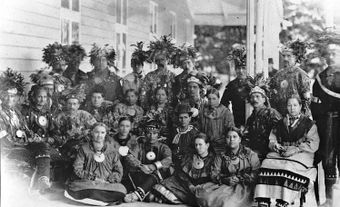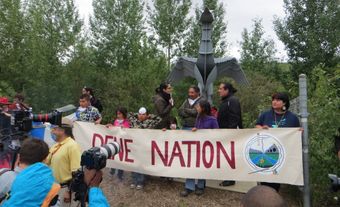
Yellowknives Dene or T'atsaot'ine are a band of the Athapaskan-speaking Dene associated with the region encompassed by the Coppermine and Yellowknife rivers, the northeast shore of Great Slave Lake, and northeast into the Barren Grounds. Yellowknives are one of the five main groups of the Akaitcho Dene First Nation of the Northwest Territories: in 2012 the registered Yellowknives population was 1439.
From the first direct contact with European traders in the 17th century until their amalgamation with other Denesuline and Tlicho, every account has described them as similar to Denesuline in language and culture. Their distinctiveness and separate name is largely based on European perception. Early in the 17th century, traders were anxious to make contact with the Aboriginal people associated with copper, thus the name Copper Indians. The name Yellowknives, and later the community of Yellowknife, is believed to be derived from the colour of the tools made from the copper metal found in the region. Samuel Hearne traveled inland to Yellowknife territory 1770-72 and dispelled the idea of rich copper deposits.

The Yellowknives were the main providers and guides for the Franklin Expedition of 1819-22. Their leader at this time, Chief Akaitcho, acquired respect from the Europeans as a strong and competent leader. To the neighbouring Native groups, he was a bullying, cruel leader with a reputation for plundering and killing. In 1823 the Tlicho made a revenge attack on a Yellowknife camp, killing most of the group. Chief Akaitcho acted as a peacemaker and in 1825 negotiated a peace treaty with Tlicho Chief Edzo, ending the warfare between the Denesuline and Tlicho. Devastated by European diseases, the Yellowknives soon thereafter ended their raids on Inuit groups, initiating a period of relatively peaceful relations between them and their neighbours.
In 1900, Emil Drygeese, the Chief from the Yellowknives Dene was chosen to meet with the Treaty Commissioner and negotiate the Akaitcho's territory into treaty. The Yellowknives were acknowledged as a distinct group (estimated population 200) when they signed Treaty No 8 at Fort Resolution along with other Aboriginal people of the area (see Treaties). Before this date, however, they began to merge with neighbouring Denesuline and Tlicho. By the 1960s Tlicho and Denesulinewere not aware of any group called Yellowknives but could recount vivid stories about Akaitcho, whom they considered to be Denesuline.
In the early 1970's, the Government of Canada announced they planned to build a pipeline in Mackenzie River valley. The Dene believed this development violated their 1900 and 1921 treaties which they understood to govern peace and friendship, however the federal government interpreted the treaties as land surrender agreements. The court case, known as the Paulette Case, was the first major case heard in Canada where evidence was provided by elders, in their own language, before a court. The testimony provided by Dene elders who were present during the original treaty negotiations provided enough ambiguity regarding the interpretation of the treaties that the government was ordered to negotiate with the Dene to clarify the land rights, resources and governance.
In the 1990s, comprehensive land claim negotiations failed. The Yellowknives Dene became part of the Akaitcho First Nations and began to participate as part of the Northwest Territories Treaty 8 Tribal Corporation to negotiate the Akaitcho Land Claim Process. The federal and territorial governments began to negotiate with smaller individual Nations including the Akaitcho First Nations to settle land claims. In 2006, the federal and NWT governments and the Yellowknives Dene First Nation (as part of the Akaitcho First Nations) signed an Interim Land Withdrawal Agreement that identified and protected areas while the negotiations for the Akaitcho Agreement continue.
Today, the two main Yellowknives Dene communities are Dettah and N'dilo located around the Great Slave Lake.
See also Aboriginal People: Subarctic.

 Share on Facebook
Share on Facebook Share on X
Share on X Share by Email
Share by Email Share on Google Classroom
Share on Google Classroom




